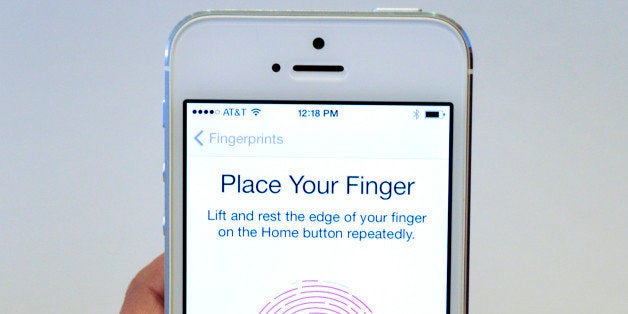
CUPERTINO, Calif. -- I was skeptical about the fingerprint-scanning technology that Apple put in its just-announced high-end iPhone 5S. Called TouchID, the feature lets you unlock your phone with your fingertip -- no more typing in a passcode.
I initially imagined Touch ID, which was announced along with the cheaper, plastic iPhone 5C on Tuesday, would be an unreliable gimmick -- something like Siri, Apple's highly touted but relatively unloved virtual assistant.
But in the few minutes I got to spend with the iPhone 5S at Apple's headquarters Tuesday, I was impressed with how easy the sensor was to set up and how quick and responsive it was.
The fingerprint scanner is Apple's most high-profile addition to the iPhone 5S, which also boasts a new, faster A7 processor, another chip that turns the device into a tracker that works as a pedometer and measures activity, an improved camera, slow-motion video capability and improved battery life.
Yet the iPhone 5S comes to market at a time when more than half of Americans already have smartphones and more of them are upgrading less frequently, happy with the features of handsets that aren't quite state of the art. Lots of overseas smartphone buyers of late are choosing so-called phablets with huge screens, and the internal tune-ups to the newest iPhone may not be enough to lure them away.
"The improvements though are harder to explain vs. saying the phone has a larger screen or a different design," Carolina Milanesi, a research vice president at Gartner, said of the 5S in an email. "But Apple does not seem to pick the easy way."
Touch ID replaces the iPhone lock code that many people use dozens of times a day to check messages and use apps. When you place your finger on the home button, Touch ID analyzes a stored image of your fingerprint and unlocks the phone.
Setting up the feature involves going to the "passcode and fingerprint" option in the phone's settings menu. The phone prompts you to "lift and rest your finger on the Home button repeatedly" over the course of about a minute, so it can get to know your unique print. The phone also asks you to place different parts of your finger on the home button so that your finger doesn't have to be in the same place each time to unlock the phone. And you can scan multiple fingers so you have options for accessing the device.
It took about a minute to set up Touch ID for my thumb. The next time I tried to unlock the iPhone 5S, I instinctively went to type in my passcode, a habit from years of typing in my four-digit code each time I unlocked my phone. But as soon as I placed my thumb on the home button, the phone unlocked and the home screen quickly appeared. I locked and unlocked it several times this way, and each time it worked flawlessly.
Beyond unlocking your handset, Touch ID can also be used to buy music, books and apps from Apple's online stores.
In the few minutes I had with the 5S on Tuesday, I was also able to check out the camera's Burst Mode, which lets you take multiple pictures in rapid succession by keeping your finger on the shutter button, a feature that other smartphones already have.
Apple's Burst Mode promises it takes at least 10 photos a second, and it delivered on that promise, snapping significantly more shots in a short period of time than the Moto X does. The idea is that the more photos you take, the more likely you are to get the right one, or you can take a series of action shots. It's also pretty easy to discard in bulk the photos you don't want.
Finally, I was impressed with the iPhone's Slo-Mo video mode that shoots video in 120 frames per second and allows you to edit right on the phone which parts of the video you want to slow down.
But the question remains of whether these features are enough to prompt people to pay $199 with a contract (or $649 without) -- at best a full $100 more than the 5C -- for the highest-end iPhone.
"We think it is," said Brian Colello, a senior equity analyst at Morningstar. "Certainly in the U.S., there's enough demand on the high end. People have been buying premium phones for years. That diehard Apple user will certainly pay for the 5S."
Milanesi, for her part, said that considering the now-discontinued iPhone 5 also had a $199 price tag when purchased with a two-year contract, the 5S "does not seem like a bad deal."